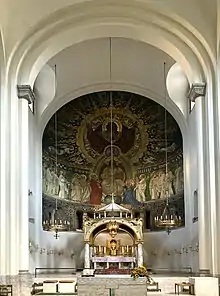Rudolf von Seitz
Rudolf (von) Seitz (15 June 1842 in Munich – 18 June 1910 in Munich) was a German painter, illustrator, and designer.
Rudolf Ritter von Seitz | |
|---|---|
 Photo of Rudolf von Seitz by Frank Eugene | |
| Born | 15 June 1842 |
| Died | 18 June 1910 (aged 68) |
| Occupation(s) | Painter, illustrator, designer, restorer, art dealer |
| Parent |
|
Career
After early art instruction from his father, decorative painter and illustrator Franz von Seitz, Rudolf enrolled in 1857 at the Academy of Fine Arts, Munich where his teachers included Karl von Piloty and Hermann Anschütz. He began with genre paintings such In Peter Vischer’s Gießhütte zu Nürnberg (trans. In Peter Vischer's Foundry in Nuremberg), but then turned primarily to illustration, applied arts and decorative painting.
Seitz's work ranged from providing the ornamental frames and print decorations in the rococo style for magnificent editions of Goethe's Faust[1][2] and Schiller's Glocke,[3] with illustrations by Sándor Liezen-Mayer, to elaborately painting the ceiling of the Bavarian court bakers and designing their bread stamps (signa pistoris).[4]
_b_501.jpg.webp)
Seitz preferred the style of the German late Renaissance and Rococo,[5] and was a leader in the Munich Kunstgewerbeverein (applied arts society), where Seitz and other leading artists designed all kinds of decorations, pageants, costumes, illustrations, graphics, and more.[6]
In 1878, together with architect Gabriel von Seidl, Seitz founded the design company "Das Renaissancemagazin Seitz & Seidl",[5][6][7] where Emanuel von Seidl soon also worked and took over the management of the interior decoration studio. The successful company existed until 1898, and its projects included the new Bavarian National Museum.[8] Seitz could design a complete range of interior furnishings: furniture, wall/ceiling paintings and ornamentation, chandeliers, windows, tapestries, ....[9] Along with his father, Seitz designed much of the interior, including many porcelain objects, for the Linderhof Palace of King Ludwig II.[7][10]

Richard Wagner asked Seitz to design "characterful, poetic and simple" costumes for the 1882 premiere of Parsifal. Seitz's spent a year on the designs,[11] but they were ultimately rejected by Wagner as "too bejewelled or too reminiscent of ballet and masquerade".[12]
In 1883 Seitz was appointed curator at the National Museum in Munich, and in 1888 he became a professor at the Munich Academy of Fine Arts, where he established an academic program in art restoration.[13] Among his students were Franz Xaver Dietrich, Julius Diez, Max Frey,[14] Julius Mössel, Richard Throll, and Rihards Zariņš.[15] Seitz's work from this era includes the large fresco in the apse of St. Anna im Lehel church in Munich in 1897 and many other ceiling and wall paintings,[16] illustrations in Jugend (magazine) such as Sommer (1898, No. 37, p. 612), Bismark (1898, No. 3, cover), and a 1905 bare-bottomed sculpture of Saint Florian[17] adorning a water fountain in Bad Tölz.

Personal life
Seitz married Carolina Paulina Marotte de Montigny (born c. 1844) in Seeon Abbey in 1869 and had a son, Hans.[5] Carolina came from a Belgian noble family, who had been admitted to the Bavarian baronial ranks with her father Karl Marotte de Montigny in 1842.[5] Seitz was ennobled as a Knight of the Order of Merit of the Bavarian Crown in 1900.[7]

After his death, an anecdote was published in many American papers,e.g.[18][19] telling of a fourteen-year boy who tried to get Seitz's autograph by a fraudulent letter, to which Seitz purportedly replied:
It often happens here on earth
That little rogues to great ones grow.
Some autographs for which you're trying
Can be procured without much lying.
External links
- Works by von Seitz at Munich's Lenbachhaus museum.
- Stucco sculptures by von Seitz on exterior walls of the Ruffinihaus in Munich.
- Seitz designs from "Das deutsche Zimmer der Renaissance", Georg Hirth, 1880: piano, bed, stove, sideboard, and washbasin
References
- Goethe, Johann Wolfgang von (1876). Faust. Verlag von Stroefer & Kirchner.
- "Christmas Books III". The Times. London, England. 14 December 1877. p. 3.
- "Gift Books for Christmas". Pall Mall Gazette. London, England. 8 December 1879. p. 10.
- "München: Hofbäckerei Anton Seidl (Brotmarke nach einem Künstlerentwurf von Rudolf von Seitz)". Wert Marken Forum. Retrieved 21 June 2023.
- Teuscher, Andrea (2010). "Seitz, Rudolf Ritter von". Neue Deutsche Biographie. 24: 203–204.
- Muthesius, Stefan (2003). "The 'altdeutsche' Zimmer, or Cosiness in Plain Pine: An 1870s Munich Contribution to the Definition of Interior Design". Journal of Design History. 16 (4): 269–290.
- "Seitz, Rudolf von (Prof.), Künstlerlexikon des Werdenfelser Landes – Textauszug aus über 4900 Kurzbiographien". Archived from the original on 3 February 2009.
- Kunstmann, Joanna Waltraud (1993). Emanuel von Seidl (1856–1919): Die Villen und Landhäuser. München: Scaneg Verlag. p. 12. ISBN 9783892350521.
- "Artists in the Castle". Museum Schloss Ratibor. Retrieved 22 June 2023.
- "Seitzstraße". Stadtgeschichte München. Retrieved 23 June 2023.
- "The Parsifal Costumes". The Indianapolis Journal. 1 August 1882. p. 2.
- Carnegy, Patrick (2006). Wagner and the art of the theatre. Yale University Press. pp. 113–114.
- von der Goltz, Michael (2022). "Education in the Art and Conservation Field in German Countries". In Dupré, Sven; Boulboullé, Jenny (eds.). Histories of Conservation and Art History in Modern Europe. Routledge. doi:10.4324/9781003127369-10.
- "Matrikelbücher der Akademie der Bildenden Künste München". Retrieved 21 June 2023.
- Ķencis, Toms (December 2015). "The Role of Folklore in the Formation of Latvian Visual Art". Folklore (Estonia). 62: 55–80. doi:10.7592/FEJF2015.62.kencis.
- Nauert, Friedrich, ed. (1888). Ceiling and wall paintings by Professor Rudolf Seitz, executed in the German national arts and crafts exhibition in Munich, 1888.
- "Stadtplan Bad Tölz: Floriansbrunnen". Retrieved 21 June 2023.
- "Current Talk". Buffalo Courier. Buffalo, NY, USA. 20 July 1910. p. 4.
- "Getting An Autograph". The Olneyville Times. Providence, RI, USA. 17 Mar 1916. p. 8.